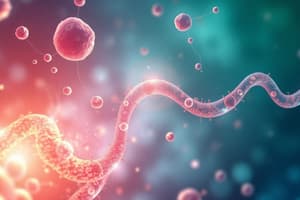Podcast
Questions and Answers
What is Pharmacokinetics?
What is Pharmacokinetics?
It is the study of what your body does to the drug
What does your body do to the drug?
What does your body do to the drug?
It absorbs, distributes, metabolizes and excretes the drug.
In the ADME principle, which step involves the movement of a drug from the site of administration into the bloodstream?
In the ADME principle, which step involves the movement of a drug from the site of administration into the bloodstream?
- Absorption (correct)
- Distribution
- Metabolism
- Excretion
In the ADME principle, which step involves the movement of the drug from the bloodstream into tissues and organs?
In the ADME principle, which step involves the movement of the drug from the bloodstream into tissues and organs?
In the ADME principle, which step involves the conversion of a drug into a different chemical form?
In the ADME principle, which step involves the conversion of a drug into a different chemical form?
In the ADME principle, which step refers to the process of removing a drug or its metabolites from the body?
In the ADME principle, which step refers to the process of removing a drug or its metabolites from the body?
Which of the following correctly identifies the two broad categories of factors that influence pharmacokinetics?
Which of the following correctly identifies the two broad categories of factors that influence pharmacokinetics?
List the specific patient factors that influence pharmacokinetics?
List the specific patient factors that influence pharmacokinetics?
List the specific drug factors that influence pharmacokinetics
List the specific drug factors that influence pharmacokinetics
Drug movement depends on ________ (I.e. solubility, ionization, molecular size) and ______ (membranes, transporters, tissue specific barriers like the BBB)
Drug movement depends on ________ (I.e. solubility, ionization, molecular size) and ______ (membranes, transporters, tissue specific barriers like the BBB)
Which of the following best describes a key determinant of drug movement across a biological membrane?
Which of the following best describes a key determinant of drug movement across a biological membrane?
Which of the following drug characteristics would MOST likely facilitate passive diffusion across a lipid bilayer?
Which of the following drug characteristics would MOST likely facilitate passive diffusion across a lipid bilayer?
Which of the following best describes the role of ATP-binding cassette sub-family B member (ABCB) transporters, such as P-glycoproteins, in pharmacokinetics?
Which of the following best describes the role of ATP-binding cassette sub-family B member (ABCB) transporters, such as P-glycoproteins, in pharmacokinetics?
In active transport, carrier proteins aren’t required.
In active transport, carrier proteins aren’t required.
How do metabolic inhibitors affect active transport mechanisms in drug movement?
How do metabolic inhibitors affect active transport mechanisms in drug movement?
How do hydrophilic and lipophilic media within cells influence drug pharmacokinetics?
How do hydrophilic and lipophilic media within cells influence drug pharmacokinetics?
Tissues that are more protected make it harder for a drug to move within the body. List examples of these tissues
Tissues that are more protected make it harder for a drug to move within the body. List examples of these tissues
Match the correcting term to it’s function/description
Match the correcting term to it’s function/description
Which of the following statements is TRUE regarding the order of drug processes?
Which of the following statements is TRUE regarding the order of drug processes?
Which of the following best describes the two components that determine the rate of drug movement?
Which of the following best describes the two components that determine the rate of drug movement?
What is a defining characteristic of zero-order kinetics in drug movement?
What is a defining characteristic of zero-order kinetics in drug movement?
What happens when drug transporters become saturated?
What happens when drug transporters become saturated?
What does the ionization of a drug depend on?
What does the ionization of a drug depend on?
When does a weak acid or weak base become "trapped" in a compartment?
When does a weak acid or weak base become "trapped" in a compartment?
When does ion trapping occur?
When does ion trapping occur?
Membranes are more permeable to ionized forms of drugs than nonionized
Membranes are more permeable to ionized forms of drugs than nonionized
What happens when the pKa of a drug equals the pH of the surrounding medium?
What happens when the pKa of a drug equals the pH of the surrounding medium?
Flashcards
Pharmacokinetics
Pharmacokinetics
The study of how the body affects a drug.
Absorption
Absorption
The process by which a drug moves from the site of administration into the bloodstream.
Distribution
Distribution
The process by which a drug moves from the bloodstream into tissues and organs.
Metabolism
Metabolism
Signup and view all the flashcards
Excretion
Excretion
Signup and view all the flashcards
Patient Factors
Patient Factors
Signup and view all the flashcards
Drug Factors
Drug Factors
Signup and view all the flashcards
Patient Factors (Specific)
Patient Factors (Specific)
Signup and view all the flashcards
Drug Factors (Specific)
Drug Factors (Specific)
Signup and view all the flashcards
Drug Transport Across Membranes
Drug Transport Across Membranes
Signup and view all the flashcards
Drug Solubility
Drug Solubility
Signup and view all the flashcards
Drug Ionization
Drug Ionization
Signup and view all the flashcards
Blood-Brain Barrier (BBB)
Blood-Brain Barrier (BBB)
Signup and view all the flashcards
Drug Chemical Transformations
Drug Chemical Transformations
Signup and view all the flashcards
Study Notes
Drug Movement Mechanisms
- Drug movement relies on chemical properties (solubility, ionization, size) and biological barriers (membranes, transporters, blood-brain barrier).
- Key mechanisms include passive transport (diffusion) and active transport (carrier-mediated).
Drug Transformations
- Drugs undergo various chemical transformations:
- Chelation (binding to metal ions)
- Hydrolysis (water-mediated splitting)
- Oxidation (electron transfer)
- Tautomerization (isomer conversion)
- Photodegradation (light-induced breakdown)
- Conjugation (attachment to endogenous molecules)
- These transformations affect drug stability, absorption, metabolism, and elimination.
Studying That Suits You
Use AI to generate personalized quizzes and flashcards to suit your learning preferences.



